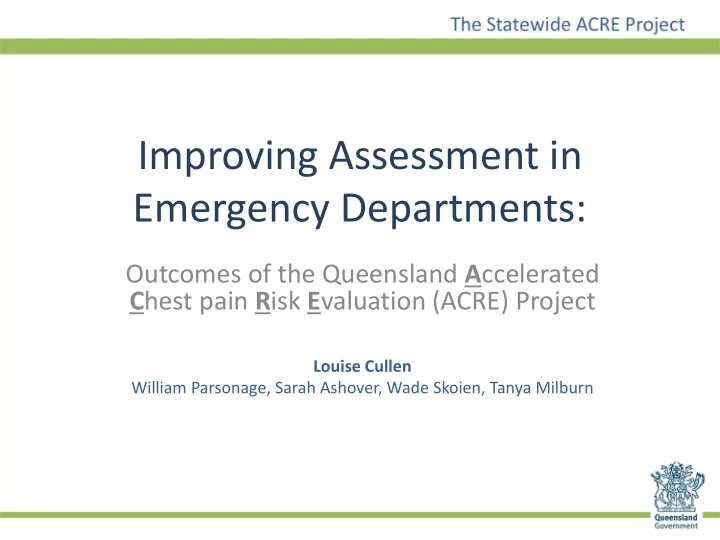

Improving Assessment in Emergency Departments: Outcomes of the Queensland A ccelerated C hest pain R isk E valuation (ACRE) Project Louise Cullen William Parsonage, Sarah Ashover, Wade Skoien, Tanya Milburn
Background – the burden of chest pain • 7.2 million hospital Emergency Australian Emergency Department Presentations Department (ED) presentations in 2013-14 to 289 Australian hospitals (AIHW) • 6-10% for chest pain • QLD Dept. of Health Statistics 2014: – 1.18 million ED presentations to 60 reporting hospitals – 77, 368 (6.5%) for chest pain
Assessment of Chest pain
The ED Physician’s Dilemma • Up to 85% of adult chest pain presentations diagnosed with non-cardiac causes • Current protocols = Extended ED stays (6-8 hours) or admission for diagnostic workup • Average time in hospital ~ 20 hours (QLD Health data)
Current Chest pain Risk Stratification
Pressure
Costs Risk Category No. of patients Median Cost per Median LOS patient (Hours) Low 9 $ 1530 11.5 Intermediate 580 $ 1849 24.5 High 329 $ 6452 72.3 Cullen L, Greenslade J, Merollini K, Graves N, Hammett CJK, Hawkins T, Than, MP, Brown AFT, Huang CB, Panahi SE, Dalton E, Parsonage W. Cost and outcomes of assessing patients with chest pain in an Australian emergency department. MJA. 2015;202(8): 427-433.
Value? Risk Category No. of Median Cost No. of ACS events Cost per ACS patients per patient event Low 9 $ 1530 0 $0 Intermediate 580 $ 1849 11 $174,191 High 329 $ 6452 92 $31,895 Cullen L, Greenslade J, Merollini K, Graves N, Hammett CJK, Hawkins T, Than, MP, Brown AFT, Huang CB, Panahi SE, Dalton E, Parsonage W. Cost and outcomes of assessing patients with chest pain in an Australian emergency department. MJA. 2015;202(8): 427-433.
ADAPT - 2012
The Accelerated Protocol (ACRE-ADP) • Risk Stratification to identify suitable patients (approx. 20%): TIMI score, ECG, Blood test • Repeat ECG and blood tests at 2 hrs. (vs 6-8 hrs.) • Can be safely discharged to return for outpatient testing (fewer admissions to await testing) • No new equipment or tests required
Length of Stay (LOS) Savings 24.5 Hours Emergency Short Stay Unit (SSU) / Ward Department (ED) 4.5 Hrs 20 Hrs 4.3 Hours SSU / ED Ward 2.0 Hrs 2.3 Hrs
The ACRE Project: Accelerated Chest pain Risk Evaluation • Translate research into practice • Shorten conventional cycle of: evidence – guidelines – clinical practice • Stage 1: Intensive but focused clinical redesign at a pilot site – Implement ADP and monitor – Clinical outcomes – ED Statistics – Patient Satisfaction • Results published 2013
Nambour General Hospital Proportion of chest pain patients eligible for ACRE-ADP • 7 months of data collected • 27,208 ED attendances • 6.5% chest pain presentations • 214 ACRE-ADP (SLIC) suitable (19%) • No adverse events at 30 days
Median ED LOS
Patient Satisfaction ‘On a satisfaction scale of 1 - 10, how would you rate the care you received?’ • 95% rated 7 or above • 77% rated 9 or above • “Couldn’t praise the care more” • “They were all over it” • “People who work in emergency deserve a medal”
Stage 2: Statewide Roll-out • Health Innovation Fund • 21 suitable hospital sites (access to laboratory blood tests) • 21 target sites = 85% of statewide chest pain presentations • Stakeholders contacted, meetings and information sessions • Funding for local project officers • Statewide data collection and analysis (EDIS project box)
Reach of the ACRE Project • 21 suitable target sites – 16 implemented – 3 in advanced planning – 2 not implementing • Including pilot site, 76% of patients presenting to ED with chest pain in QLD will have the opportunity to be assessed under the ACRE Protocol
Uptake of the Protocol • To June 2015, 5112 patients had been assessed as suitable for ACRE-ADP and undergone fast-tracked assessment = 23% of patients presenting with chest pain at participating hospitals
Hospital Length of Stay (LOS) • 32% reduction from 1238 mins (20.6 hrs) to 837 mins (14 hrs) 20.6 • ACRE-ADP patients (24%) hrs 14.0 LOS = 310 mins (5.1 hrs) hrs • Non ACRE-ADP LOS = 1208 mins (20 hrs)
Emergency Department LOS • 11% reduction in total ED LOS • ACRE-ADP patients LOS = 179 mins 236 212 min • Non ACRE-ADP patients min LOS = 224 mins • Modest in isolation, but very significant when scaled across sites
Hospital Admissions • 19% of ACRE-ADP eligible 69% 57% patients admitted • 69% non ACRE-ADP admitted
Summary • Chest pain assessment in the ED is a common and costly process. • Evidence for accelerated, safe assessment strategies exists. • Translation of research into clinical practice requires resources. – Need clinician engagement • Self-sustaining process with ongoing release capacity – ACRE-ADP integrated into usual practice – Incorporated into new Statewide Clinical pathways
Thank you for listening Questions? Supported by: Queensland Department of Health Healthcare Improvement Unit Metro North Hospital and Health Service
Recommend
More recommend